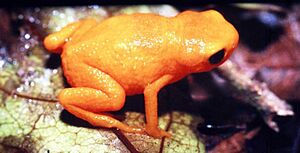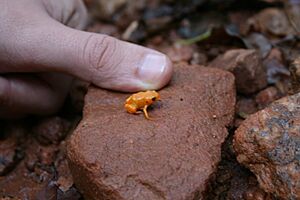Pumpkin toadlet facts for kids
Quick facts for kids Pumpkin toadlet |
|
|---|---|
 |
|
 |
|
| Close-up (above), size compared to a human thumb (below) | |
| Conservation status | |
| Scientific classification |
The pumpkin toadlet (Brachycephalus ephippium), also known as Spix's saddleback toad, is a small and very colorful frog. It belongs to the Brachycephalidae family. This toadlet is active during the day, which means it is a diurnal animal.
You can only find this species in southeastern Brazil. It lives among leaf litter on the ground of the Atlantic rainforest. It can be found at heights from about 200 to 1250 meters (650 to 4100 feet) above sea level. The pumpkin toadlet lives in the Brazilian states of Espírito Santo, Rio de Janeiro, southeastern São Paulo, and southeastern Minas Gerais. Even though it was thought to be found in Bahia about 200 years ago, there are no recent confirmed sightings there. Scientists now think the first one found probably came from Rio de Janeiro. This toadlet is quite common in its areas and is not considered threatened.
The pumpkin toadlet eats tiny invertebrates, which are small creatures without backbones. When they reproduce, the female lays a few eggs on land. These eggs hatch directly into tiny toadlets, meaning there is no tadpole stage like with many other frogs.
What Does the Pumpkin Toadlet Look Like?

The pumpkin toadlet is a very small frog. Adult toadlets are usually between 12.5 and 19.7 millimeters (about 0.5 to 0.8 inches) long from their snout to their vent (the opening at the end of their body). Even though they are small, they are among the largest in their group of frogs, the Brachycephalus genus. Female toadlets are usually a bit bigger than males. When they first hatch, baby pumpkin toadlets are only about 5.25 to 5.45 millimeters (about 0.2 inches) long.
Adult pumpkin toadlets are a bright yellow-orange color. This bright color is a warning sign to predators, meaning they are aposematic. This is because their skin and organs contain powerful toxins, like tetrodotoxin. When they are newly hatched, the toadlets are brown. This helps them blend in with their surroundings and stay hidden.
Scientists have found special types of toxins in these toadlets. One of these, called 11-oxoTTX, is very rare in other animals. It is even more powerful than tetrodotoxin itself. These toxins are found in their skin and ovaries, but most of them are in their liver.
In 2019, scientists made an amazing discovery about the pumpkin toadlet. They found that the toadlet's head and back glow under ultraviolet light. This glow comes from their fluorescent skeletons. Interestingly, young toadlets that have turned yellow-orange like the adults do not yet have this glowing ability.
At first, scientists thought the glowing might also be a warning sign to predators. They also thought it might help the toadlets choose a mate. However, later studies showed that the glowing probably does not scare away predators.
How Do Pumpkin Toadlets Communicate?
The pumpkin toadlet and its close relative, the red pumpkin toadlet, have a unique problem. They cannot hear the sounds of their own calls because their ears are not fully developed. This means they cannot hear their own "advertisement calls" that other frogs use to attract mates.
Instead of relying on sound, these toadlets communicate using special movements. They might inflate their vocal sac (the part of their throat that puffs up when they call), open their mouths wide, or wave their arms. Scientists believe that their calling sounds might be a leftover trait from their ancestors. Their reduced hearing ability, however, is a new change in these species. They can still hear some sounds, just not the ones they make themselves. Even though making sounds might attract predators, their toxic skin protects them, so there hasn't been much pressure for them to stop calling.
See also
- Polka-dot tree frog (Hypsiboas punctatus) — the first frog discovered to be fluorescent, in 2017


